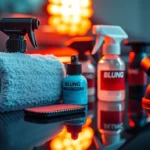Understanding Sublimation Uniforms: Basics and Benefits
Sublimation uniforms have revolutionized the sports apparel industry by offering innovative, vibrant, and durable customization options. Unlike traditional methods such as screen printing or embroidery, sublimation allows for full-color, all-over designs that seamlessly integrate with the fabric, creating uniforms that are both visually striking and long-lasting. If you’re involved in sports team management, apparel design, or manufacturing, exploring the nuances of sublimation uniforms can significantly enhance your product offerings and team branding efforts. To begin, it’s crucial to understand what sublimation uniforms are and how they differ from conventional sports kits.
For comprehensive insights and to explore various options, visit sublimation uniforms, which offers a wide range of customizable sports apparel tailored to meet diverse needs.
What Are Sublimation Uniforms and How They Differ from Traditional Kits
Defining Sublimation Uniforms
Sublimation uniforms are sports apparel created using a dye sublimation printing process. This technique involves turning dye-based inks into gas without passing through a liquid state—directly transferring the ink into the fabric fibers. As a result, designs are embedded within the fabric itself, leading to no surface layering or cracking over time.
Differences from Traditional Sports Kits
- Design Capabilities: Sublimation enables full-coverage, complex, multi-color graphics that cover entire garments, whereas traditional kits rely on patchwork, embroidery, or limited print areas.
- Durability: Since the ink is embedded into the fabric, sublimated uniforms resist fading, cracking, and peeling, unlike screen-printed or vinyl designs.
- Fabric Flexibility: Sublimation uniforms maintain the fabric’s original softness and stretch, critical for athletic performance, unlike rigid embroidery or adhesive patches.
- Cost Considerations: Initial setup and equipment costs for sublimation can be higher, but the per-unit production cost decreases significantly at scale.
Advantages of Sublimation Printing in Sports Apparel
Vibrant and Unlimited Design Possibilities
Sublimation printing offers the freedom to incorporate intricate patterns, gradients, photographs, and multi-layered graphics into uniforms. This capability enhances team branding, allows custom art integration, and boosts the aesthetic appeal of sportswear, making teams stand out on the field or court.
Enhanced Durability and Longevity
Because dyes are embedded directly into the fabric fibers, sublimation uniforms resist wear and tear far better than conventional printing methods. They maintain their vivid appearance wash after wash, reducing the need for frequent rebranding or replacement.
Comfort and Performance
Unlike bulky heat transfers or patches, sublimation fabrics preserve their original flexibility, breathability, and moisture-wicking properties—crucial for athletic performance. Athletes experience less discomfort, and uniforms stay lightweight and non-restrictive.
Cost-Effectiveness at Scale
Although initial investment is substantial, bulk orders of sublimation uniforms become cost-effective, especially for varsity teams, leagues, and professional clubs. Their high durability also ensures better long-term value for teams looking for reliable, match-ready kits.
Common Materials and Fabrics Used for Sublamation Uniforms
Polyester and Polyester Blends
The most widely used fabrics for sublimation are polyester and polyester blends due to their affinity for accepting dye sublimation inks. Typically, fabrics with at least 70% polyester content are ideal to ensure vibrant color reproduction and durability.
Performance Fabrics
Specialized performance fabrics—such as moisture-wicking polyester meshes—are commonly chosen for active sportswear. These fabrics provide breathability, quick-drying capabilities, and flexibility, all of which enhance athlete comfort and performance.
Fabric Weight and Weave
Fabric weight influences the feel and durability of the uniform. Lightweight fabrics (around 150-200gsm) are suitable for high-intensity sports, while heavier fabrics (200+gsm) provide sturdiness for colder conditions. The weave (knit versus woven) also affects stretchability and breathability, critical factors in performance uniforms.
Designing Sublimation Uniforms: Tips and Best Practices
Creating Eye-Catching Custom Graphics and Logos
Designing compelling graphics is the cornerstone of effective sublimation uniforms. Use high-resolution images and vector graphics to maintain clarity. Incorporate team logos, player names, and numbers with clear contrasts for readability. Consider integrating thematic patterns or gradients that complement the team’s identity. Collaborating with professional graphic designers or utilizing specialized software can significantly enhance design quality.
Color Matching and Pantone Alignment for Vibrant Prints
Achieving consistent and vibrant colors requires precise color management. Utilize Pantone color matching systems to ensure color accuracy across different batches. When designing, work within the color profiles supported by your sublimation printer and fabric type to prevent color bleeding or dullness. Test prints are crucial before bulk production to fine-tune color fidelity.
Software Tools and Design Templates for Personalized Uniforms
Popular design software like Adobe Illustrator, CorelDRAW, or specialized sports uniform design tools facilitate the creation of detailed templates. Many manufacturers provide customizable design templates that streamline the process for teams with limited graphic design experience. Leveraging these tools ensures high-quality, scalable designs tailored to your specifications.
Manufacturing and Quality Control of Sublimation Uniforms
Choosing Reliable Suppliers and OEM Partners
Partnering with experienced manufacturers who demonstrate quality assurance, consistent delivery, and advanced equipment is essential. Look for those with certifications such as ISO or SGS testing, and review their portfolio of past projects. OEM collaborations enable brands to maintain control over design, fabric sourcing, and production timelines.
Ensuring Fabric Durability and Color Fading Resistance
High-quality sublimation requires using durable polyester fabrics and state-of-the-art printing machines. Conduct sample testing to evaluate colorfastness and fabric resilience through repeated wash cycles. Implement strict quality checks at each stage—fabric inspection, printing, and finishing—to detect defects early.
Sample Testing and Quality Assurance Protocols
Before mass production, produce samples for thorough testing. Assess print clarity, color vibrancy, fabric stretch, and adherence to design specifications. Establish quality benchmarks and perform stress tests under simulated wash and wear conditions. Continuous feedback loops with suppliers improve overall product quality over time.
Implementation and Cost Considerations
Estimating Production Costs and Bulk Order Discounts
Cost factors include fabric selection, design complexity, quantity, and printing technology. Bulk orders typically attract discounts, reducing per-unit expenses. To optimize costs, plan for scalable orders, negotiate pricing with suppliers, and consider the total lifecycle costs—long-term durability reduces replacement expenses.
Lead Times and Ordering Processes
Lead times vary based on project complexity and supplier capacity, typically ranging from 2-6 weeks. Establish clear communication channels, provide detailed specifications upfront, and set realistic timelines. Using digital mockups accelerates approvals and streamlines the workflow.
Effective Strategies for Selling Sublimation Uniforms Online
Offer customization options, high-definition product images, and clear sample visuals on your website. Highlight benefits like durability and vibrant aesthetics. Utilize SEO strategies centered around keywords such as ‘custom sublimated jerseys’ and ‘sports uniforms,’ and strategically target teams, schools, and sports clubs for outreach.
Performance, Maintenance & Future Trends
Wear and Care Tips to Maintain Vibrancy
To preserve the bright colors and integrity of sublimation uniforms, wash inside out in cold water, avoid bleach and fabric softeners, and air-dry or tumble dry on low heat. Avoid ironing directly on printed areas. Proper maintenance extends the lifespan of vivid artwork and fabric performance.
Measuring Performance Results for Team Satisfaction
Gather feedback via surveys on comfort, durability, and aesthetics after several wears and washes. Track performance metrics like color retention, fabric strength, and player satisfaction to inform future designs and manufacturing improvements.
Emerging Trends and Innovations in Sublimation Sportswear
The future of sublimation uniforms is leaning toward eco-friendly fabrics, faster printing technologies, and smart textiles embedded with sensors for performance tracking. Augmented reality (AR) features for custom design previews and AI-assisted graphic creation are also promising advancements improving personalization and turnaround times.









